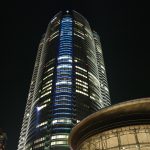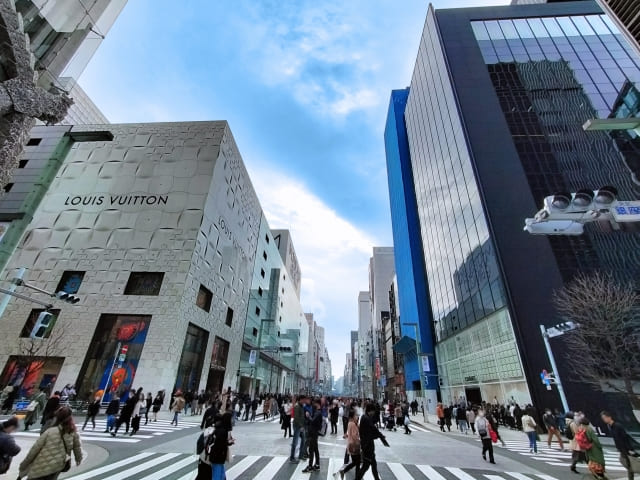
Ginza area, positioned at the heart of Tokyo, stands as a vital business and commercial district, cherished for its convenient access to the city center. Here is a detailed explanation of Ginza’s location.
First and foremost, Ginza is located in the Chuo Ward of Tokyo. It serves as one of the central hubs for government institutions, major corporations, and financial entities, making it a focal point for business-related facilities.
Ginza is relatively close to major stations such as Tokyo Station, Shimbashi Station, and Yurakucho Station. This proximity ensures excellent access to the city center, facilitating smooth commuting and business trips. Moreover, it boasts convenient connections to Haneda Airport and Narita International Airport, establishing itself as an outstanding international business hub.
Ginza area functions as a transportation hub, intersecting various modes of transportation including Tokyo Metro, Toei Subway, and JR lines. This facilitates easy movement to other areas, making it versatile for purposes such as tourism, shopping, business meetings, and more.
Furthermore, the surroundings of Ginza feature a concentration of high-end hotels, restaurants, shopping malls, theaters, and art museums. This abundance of facilities offers a diverse range of experiences, allowing visitors to enjoy Japanese culture and entertainment.
In summary, the location of the Ginza area excels in providing unparalleled access to the city center. Its concentration of diverse facilities makes it an attractive destination catering to various needs, including business, tourism, shopping, and more.
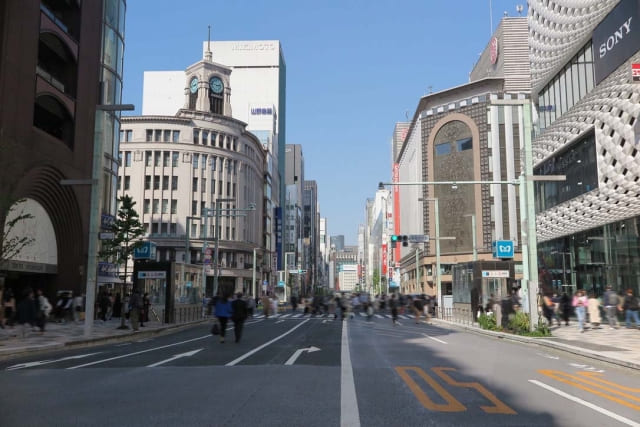
Shopping in the Ginza area offers a luxurious and diverse experience, making it a prime destination for those seeking upscale products and unique finds. Here’s a detailed overview of shopping in the Ginza area.
Luxury Brand Shopping: Ginza is renowned for its concentration of high-end brands and designer boutiques. Along Chuo Dori and its surrounding streets, you’ll find flagship stores and boutiques from both domestic and international luxury brands, showcasing the latest fashion trends and premium-quality products.
Department Stores: Ginza boasts several prominent department stores, including Ginza Mitsukoshi and Matsuya Ginza. These establishments provide a lavish shopping environment with a wide range of products, from clothing and cosmetics to jewelry and electronics. Visitors can explore multiple floors, each offering a curated selection of top-tier goods.
Traditional Crafts: For those interested in traditional Japanese craftsmanship and art, Ginza offers shops specializing in traditional pottery, lacquerware, and handmade crafts. These stores provide an opportunity to acquire unique and authentic pieces reflecting Japan’s rich cultural heritage.
Jewelry Shops: Ginza is a hub for exquisite jewelry and precious stones. Numerous jewelry shops in the area showcase beautiful diamonds and colorful gemstones, making it an ideal location for those looking to purchase high-quality jewelry for special occasions.
Curios and Antiques: Explore small curio shops and antique stores in Ginza to discover charming trinkets and unique vintage items. These shops offer a diverse selection of goods, making them perfect for finding distinctive souvenirs or gifts.
Cafes and Specialty Stores: Ginza is home to a variety of cafes and specialty stores. Indulge in delicious Japanese sweets, matcha-flavored treats, or visit specialty coffee shops for a unique culinary experience amid your shopping spree.
In summary, the Ginza area provides a shopping haven with a mix of luxury, tradition, and uniqueness. Whether you’re interested in high-end fashion, traditional crafts, or eclectic finds, Ginza’s opulent shopping environment caters to a wide range of preferences, offering a fulfilling and memorable shopping experience for all visitors.
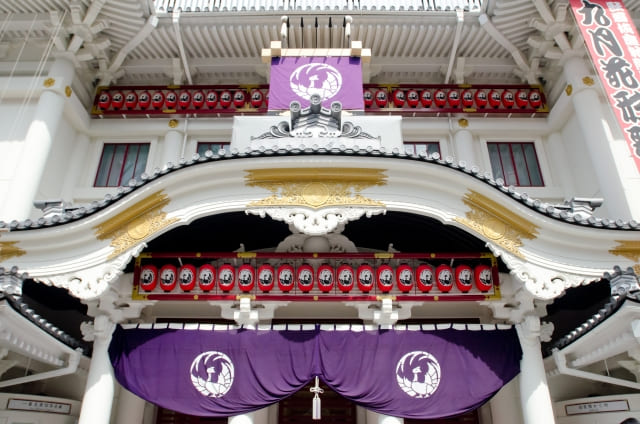
In Ginza, Tokyo, you can find the iconic Kabuki-za Theater, a dedicated venue for Kabuki, a traditional Japanese theatrical art form. Kabuki-za, located in the heart of Ginza, serves as a theater for the performance of Kabuki plays, showcasing the rich cultural heritage of Japan.
The history of Kabuki-za dates back to 1889, and the current building, opened in 2013, combines traditional Japanese architectural elements with modern features, offering a unique and comfortable environment for theatergoers. The exterior reflects Japan’s cultural traditions, while the interior provides a pleasant atmosphere for enjoying the captivating performances.
Kabuki-za offers an immersive experience of Kabuki, characterized by distinctive stage settings, elaborate makeup, and expressive acting techniques. The plays cover a diverse range, including historical dramas, contemporary stories, and traditional narratives. The actors, with their unique skills, captivate the audience and bring the stories to life on stage.
As the primary venue for Kabuki in Tokyo, Kabuki-za plays a vital role in preserving and promoting Japan’s cultural identity. It attracts visitors from both Japan and abroad, offering them a chance to appreciate the beauty and artistry of Kabuki. The performances at Kabuki-za provide a valuable opportunity to delve into Japan’s history, traditions, and the artistic brilliance of the country’s theatrical heritage.
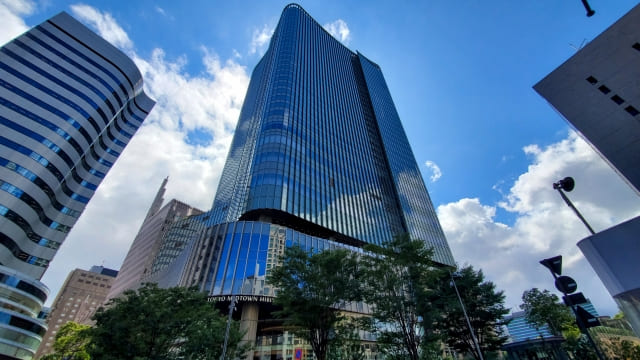
The area around Hibiya Station is a vibrant blend of business and entertainment. Hibiya Midtown, a complex featuring towering buildings, shopping malls, and restaurants, has become a hub for international corporations and renowned brands. It offers convenient office spaces and conference facilities for business professionals, along with opportunities for shopping and gourmet experiences.
Hibiya Park, situated in the heart of the business district, is a beautiful park where nature harmonizes with history. With seasonal flowers, lush greenery, and open spaces, the park serves as a peaceful retreat for both locals and tourists. Historical structures and fountains within the park add to its charm, providing a tranquil setting for visitors.
Known as a business district with a concentration of government institutions and corporate headquarters, Hibiya is home to key public facilities such as the Ministry of Foreign Affairs and the Chiyoda City Office. This area functions as an international business hub, attracting numerous companies to establish offices and providing excellent accessibility for business professionals.
In summary, the Hibiya area seamlessly integrates business, culture, and nature, offering a diverse range of attractions and amenities.
Ginza is generally considered a very safe area. Being located in the heart of Tokyo, active police patrols and surveillance contribute to creating an environment where both tourists and local residents can walk around with a sense of security.
Known as a vibrant commercial district during the day, Ginza is home to numerous high-end brand stores, restaurants, and entertainment facilities. Even during the night, the area is well-lit with street lamps and building lights, making it generally safe for pedestrians to move around.
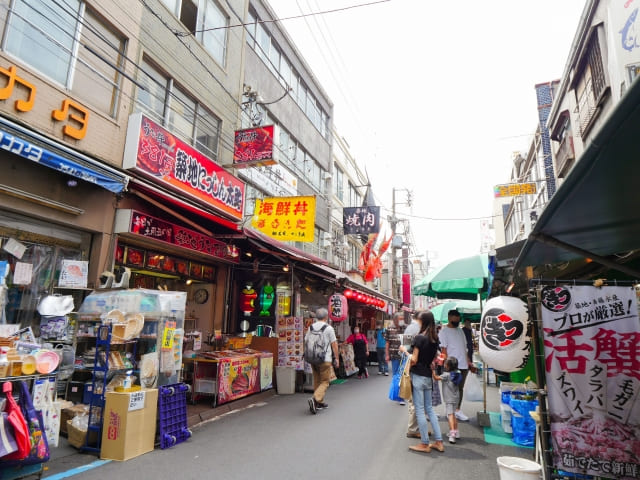
Tsukiji Market is relatively close to Ginza. Ginza and Tsukiji are both located in the central part of Tokyo and are geographically adjacent. Typically, you can travel a few kilometers using a taxi or the subway.
By using the Tokyo Metro Ginza Line, you can cover the distance from Ginza to Tsukiji in just a few subway stops. Alternatively, taking a taxi for this short distance is convenient.
Tsukiji Market, once the largest wholesale market in the world, is famous for trading fresh seafood, vegetables, fruits, and more. Even though Tsukiji Market has been relocated to Toyosu Market, the area around Tsukiji still retains its historical and cultural significance.
In the vicinity of Tsukiji, you’ll find numerous restaurants and eateries that use fresh ingredients sourced from the market. Sushi restaurants, in particular, are popular among both tourists and locals, playing a significant role in showcasing the symbolic food culture.
Tsukiji offers a unique culinary experience and food culture. Despite the market’s relocation to Toyosu, Tsukiji continues to be a hub for historical importance and a source of new culinary trends.
With a history dating back to the Edo period, Tsukiji preserves its traditional streetscape and historic buildings. The name “Tsukiji” originates from the construction of water channels and irrigation ditches in this area. Surrounding the market, you can explore shrines, temples, and historical structures, allowing you to immerse yourself in the nostalgic atmosphere of old Japan.
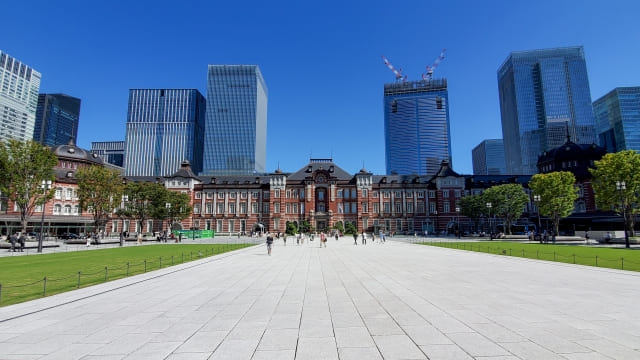
Tokyo Station, located in Chiyoda ward, is a major railway terminal situated at the heart of Tokyo, the capital of Japan. Positioned in Tokyo’s central business district where government institutions and major corporations converge, the station is also in close proximity to the Imperial Palace, adding historical charm to the surroundings.
Known for its historical significance, Tokyo Station is admired for its architectural design. The Marunouchi Station Building, in particular, is celebrated for its beautiful brick construction, exuding an atmosphere that resonates with history and making it a notable tourist attraction. This building has been designated as a registered tangible cultural property by the Japanese government.
The station serves as a vital transportation hub, connecting various railway lines that facilitate travel within Tokyo and beyond. Its iconic Marunouchi Building offers not only transportation services but also a diverse range of shopping areas and dining establishments. From high-end brands to everyday essentials, the station caters to the needs of commuters and visitors alike, providing a space for relaxation and enjoyment.
In summary, Tokyo Station is not only a crucial transportation center but also a cultural and commercial hub, blending historical significance with modern convenience. The Marunouchi Station Building stands as a testament to Japan’s architectural heritage, attracting people from all walks of life to experience its unique blend of history and contemporary amenities.
Tokyo Station is a crucial transportation hub located in the heart of Tokyo, the capital city of Japan.
It serves as a major nexus for various railway lines, including Shinkansen (bullet trains), JR East Japan’s key routes, Tokyo Metro, Toei Subway Oedo Line, and Tokyo Monorail. Shinkansen lines such as the Tokaido Shinkansen and Tohoku Shinkansen provide high-speed connectivity to major cities.
JR East Japan’s extensive network, encompassing the Yamanote Line, Chuo Line, Keiyo Line, and Sobu Main Line, facilitates convenient access to the Tokyo metropolitan area. Additionally, Tokyo Metro and other urban transit systems offer diverse connections to different parts of the city.
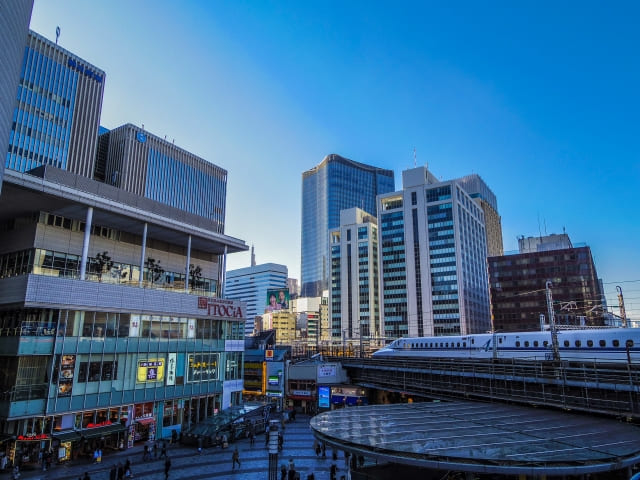
Yurakucho is an area adjacent to Ginza, and it is within a few minutes’ walk, making it a very close and accessible location. The surroundings of Yurakucho Station blend the aspects of a business district with the charm of a tourist and shopping area.
The Yurakucho Denki Building stands as a landmark in the vicinity of Yurakucho Station, featuring a high-rise building with a shopping mall and a diverse range of dining options. The building is illuminated at night, offering a stunning view of the city lights.
Yurakucho Marion is a shopping mall where luxury brands, fashion items, and miscellaneous goods stores are located. Visitors can not only purchase high-quality products but also relax in cafes and restaurants.
The Shin-Yurakucho Building is a business building with offices and dining establishments, often used for shopping and business meetings.
The Tokyo International Forum, located near Yurakucho Station, is a striking architectural marvel serving as an international event facility. It hosts concerts, exhibitions, conferences, allowing visitors to immerse themselves in art and culture.
The diverse array of dining options around Yurakucho includes traditional Japanese cuisine and international dishes, providing a delightful dining experience amid shopping and sightseeing. Yurakucho Station’s vicinity, with its concentration of tourist attractions and commercial facilities, offers a wide range of activities for visitors to enjoy.
歴史
Ginza is one of Japan’s most luxurious and bustling commercial districts, situated in the heart of Tokyo. Its development began in the late Edo period and early Meiji period when it was known as “Ginza” due to the presence of silverware workshops.
As the city underwent modernization in the Showa era, Ginza flourished with the construction of high-rise buildings and modern commercial facilities. Post-war, during Japan’s economic recovery, Ginza experienced a resurgence in prosperity.
Entering the high-growth period, Ginza became a hub for international shopping and luxury brands. Many high-end brands and department stores established their presence, contributing to its elegant ambiance.
Ginza thrived as a cultural and entertainment center with theaters, cafes, and restaurants. Iconic venues like Kabuki-za and small theaters enriched the area with traditional performing arts.
During the Bubble Economy era, the value of land and properties in Ginza skyrocketed, solidifying its status as a center for luxurious shopping and entertainment.
In contemporary times, Ginza continues to showcase high-end brands, restaurants, cafes, and entertainment facilities. It stands as a landmark in Tokyo, offering a sophisticated shopping experience and an opportunity for locals and tourists to enjoy moments of elegance.
educational institutions
In the Ginza area, there are various educational institutions catering to international students, including language schools, vocational colleges, and art and cultural centers. Numerous language schools offer courses in multiple languages, primarily focusing on Japanese and English, providing foreign tourists and students with opportunities to enhance their language skills.
Vocational colleges with a focus on design, business, art, and other specialized fields also contribute to the educational landscape. These institutions allow students to refine specialized skills aligned with their interests and career goals. Additionally, art and cultural centers serve as venues for exploring various art forms, such as painting, music, and performing arts, fostering the development of individual artistic talents.
The business-centric nature of the district has led to the presence of institutions providing training and skill enhancement in business-related fields. Programs tailored for corporations and business professionals are readily available, contributing to the professional development of individuals within the business district.
For those interested in hobbies and lifestyle-related classes, cultural centers in the Ginza vicinity offer diverse courses. Subjects range from cooking to flower arrangement and art workshops, providing an open space for individuals seeking to learn across various fields.
Ginza stands as a hub for diverse educational institutions, accommodating individuals with different interests and goals, making it a place where one can pursue education tailored to their preferences.
Transportation
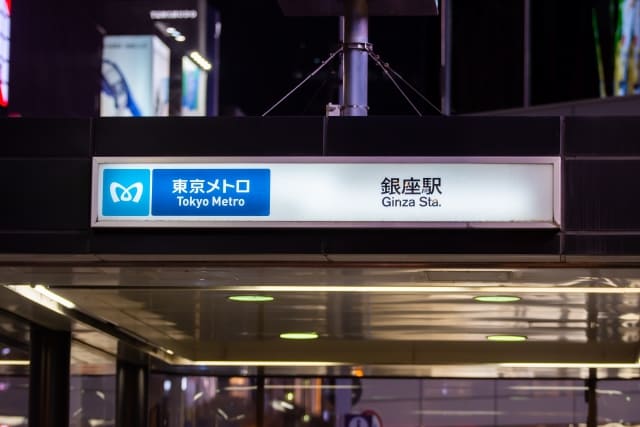
The Ginza area, situated in the heart of Tokyo, boasts excellent transportation options, making it a convenient hub for locals and visitors alike. Here is an overview of the major transportation modes in the Ginza area.
Ginza Station is a vital station located in Chuo Ward, Tokyo, at the heart of the city. Its strategic location in central Tokyo ensures excellent access to major urban areas and tourist destinations, contributing to its reputation as a bustling commercial district.
Ginza Station serves as a hub for three major Tokyo Metro lines—Ginza Line, Marunouchi Line, and Hibiya Line. Positioned at the nexus of these lines, commuters can easily utilize the Tokyo Metro network, facilitating seamless travel throughout the city.
The Ginza Line connects Shibuya to Asakusa, allowing passengers at Ginza Station to transfer efficiently to key areas in central Tokyo.
The Marunouchi Line provides access to destinations such as Nakano and Ogikubo, extending its reach to the western parts of Tokyo.
Hibiya Line offers convenient routes to locations like Roppongi and Hamamatsucho, enhancing connectivity for business and leisure travelers. This intersection of multiple lines makes Ginza Station a central transportation hub accommodating diverse travel needs.
Ginza’s strategic position extends beyond the transportation network. The surrounding area features high-end shopping districts, gourmet dining, entertainment, and cultural attractions. This confluence of facilities makes Ginza Station not only a transit point but also a vibrant center catering to various lifestyle preferences.
In conclusion, Ginza Station’s central location in Chuo Ward, Tokyo, coupled with its connectivity to three major Tokyo Metro lines, positions it as a pivotal transportation hub. Its accessibility, paired with the richness of commercial and cultural offerings in the vicinity, solidifies Ginza Station as a versatile nexus meeting the diverse needs of commuters and visitors alike.

Ginza-itchome Station is a vital station located in Chuo Ward, Tokyo, at the heart of the city. Serving as a station on the Tokyo Metro Yurakucho Line, it occupies a central position within the Ginza area.
As a part of the Yurakucho Line, Ginza-itchome Station plays a crucial role in connecting Tokyo’s major business and commercial districts. The Yurakucho Line extends across the east and west directions, and Ginza-itchome Station sits strategically in the middle. This location provides convenient access to key destinations such as Tokyo Station, Yurakucho Station, and the Shinjuku area.
The surroundings of Ginza-itchome Station are characterized by the concentration of high-end shopping areas, restaurants, and entertainment facilities in the Ginza district. People using the station can easily access a variety of commercial establishments and tourist attractions. The station also facilitates smooth commuting to the business district.
Ginza-itchome Station, as part of the Tokyo Metro network, ensures efficient connectivity to various parts of Tokyo. Its central location, coupled with the appeal of the Ginza area, makes it a preferred choice for both tourists and business commuters, offering the convenience of accessing the richness of Ginza’s commercial offerings and the broader Tokyo city center.
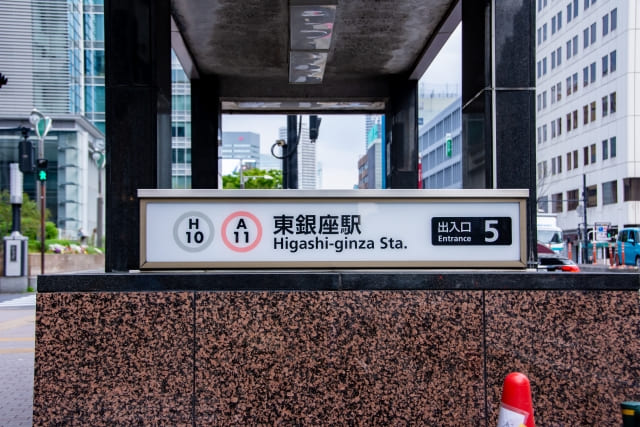
Higashi-Ginza Station is a pivotal stop on the Tokyo Metro’s Yurakucho Line, positioned on the eastern side of the prominent Ginza district. The Yurakucho Line runs horizontally, and Higashi-Ginza Station serves as a central point, offering convenient access to Tokyo Station, Yurakucho Station, and destinations in the Shinjuku area.
The surroundings of Higashi-Ginza Station are characterized by the eastern extension of the upscale Ginza area. This locale boasts a sophisticated atmosphere with a blend of traditional charm and modern elegance. The station serves as a gateway to this refined district, providing seamless access for tourists and business users to explore the exquisite commercial facilities and cultural landmarks that define the eastern part of Ginza.
The Tokyo Metro Yurakucho Line not only facilitates travel to key destinations within the city but also contributes to the accessibility and vibrancy of the broader Tokyo metropolitan area. Higashi-Ginza Station plays a vital role in connecting the eastern Ginza area with other central hubs, enhancing its significance for both residents and visitors.
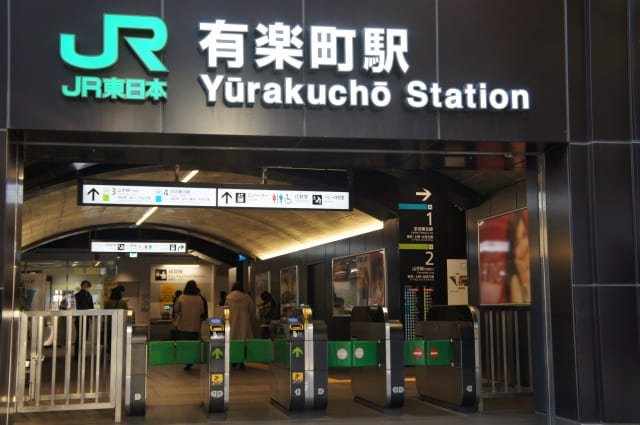
Yurakucho Station is renowned as a business hub with major corporations and commercial facilities lining the area. Landmark structures such as Yurakucho Denki Building and Yurakucho Marion contribute to its significance, serving as convenient landmarks for tourists and business users alike.
Positioned on the Yamanote Line, a key circular rail route in Tokyo, Yurakucho Station is an integral part of this line. This location ensures excellent accessibility, providing convenient connections to major Tokyo stations such as Tokyo, Shinjuku, and Shibuya from Yurakucho Station.
Furthermore, Yurakucho Station serves as the starting point for the Yurakucho Line. This east-west subway line is crucial, connecting Tokyo Station, Ikebukuro Station, Shinjuku Station, and other significant locations. Utilizing the Yurakucho Line from Yurakucho Station enables easy access to various areas within Tokyo.
Overall, Yurakucho Station stands as a strategic point with its position on the Yamanote Line and as the origin of the Yurakucho Line, offering seamless transportation and making it a prime location for both business and leisure activities.
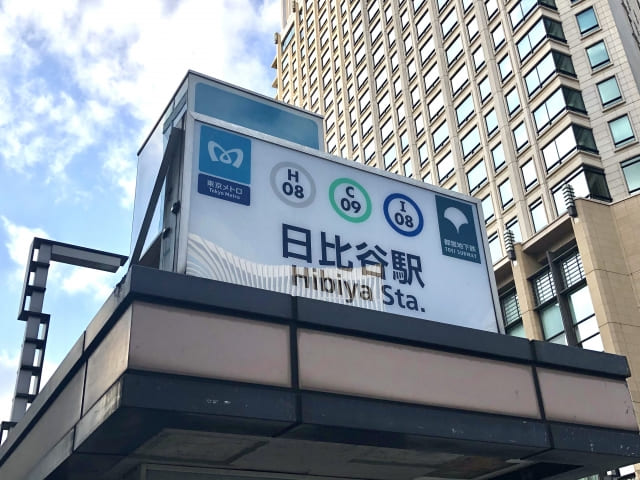
Hibiya Station is a convenient transportation hub located in the heart of Tokyo.
It serves as a pivotal point for both the Tokyo Metro Chiyoda Line and the Tokyo Metro Yurakucho Line, offering excellent connectivity to the city center and beyond.
The Chiyoda Line, a major Tokyo Metro route, runs from Chiyoda Ward in Tokyo to the west, traversing key areas. This enables easy access from Hibiya Station to prominent locations such as Tokyo Station, Chidorigafuchi, Yoyogi, and Shibuya.
Furthermore, the Yurakucho Line also passes through Hibiya Station, providing east-west connectivity. This facilitates seamless travel to stations like Yurakucho, Ikebukuro, and Shinjuku, making it convenient for commuters and tourists to access various central areas of Tokyo.
Surrounded by government institutions, major corporations, and commercial facilities, the Hibiya Station vicinity is recognized as a bustling business district. As a result, Hibiya Station is highly regarded for its convenience, serving both business professionals and tourists alike as a pivotal transportation hub equipped with diverse transit options.
Ginza’s strategic location and well-connected transportation infrastructure make it an accessible and efficient area for both daily commuting and leisure activities. Whether navigating the bustling streets for shopping or exploring nearby districts, the diverse transportation options contribute to the overall convenience of the Ginza experience.
Real estate value
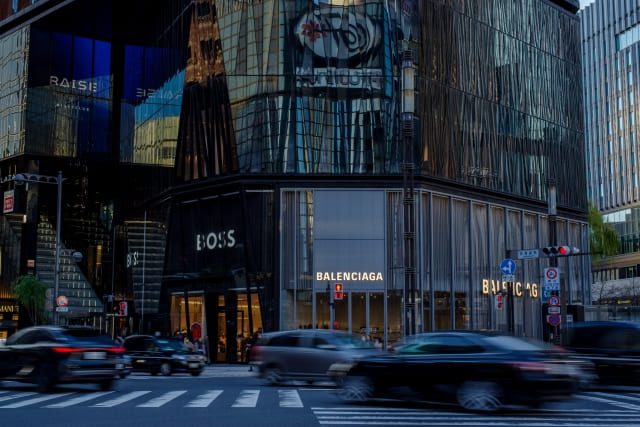
Real estate in the Ginza area holds significant value due to its central and luxurious location, surrounded by diverse high-end facilities. Ginza stands out as one of Tokyo’s most bustling and commercial districts, and the land and buildings in this area generally command high prices in real estate transactions.
Firstly, the value of land in Ginza is exceptionally high due to its central location in the heart of the city. The location is a crucial factor influencing prices in the real estate market, and Ginza’s accessibility to transportation and proximity to commercial facilities make it an attractive place for investors and residents alike.
Moreover, Ginza offers a wealth of high-end shopping areas, restaurants, and entertainment facilities, making it an ideal location for those seeking a sophisticated lifestyle. Residential and commercial properties in the Ginza area are well-regarded for their luxurious designs and amenities.
However, this high demand has led to a corresponding increase in real estate prices in the Ginza area. Especially, transactions involving high-end residences and commercial properties occur within limited spaces, and the scarcity of such properties contributes to driving prices upward. Ginza’s luxury real estate is also attracting attention as an investment target for both domestic and international affluent individuals and corporations, contributing to a balance between supply and demand that stabilizes prices.
In summary, real estate in the Ginza area holds high value due to factors such as location, facilities, and a rich lifestyle. Correspondingly, prices in this area remain at a high level. When investors or residents seek real estate in Ginza, transactions are conducted with consideration for its attractive features and future development prospects.


